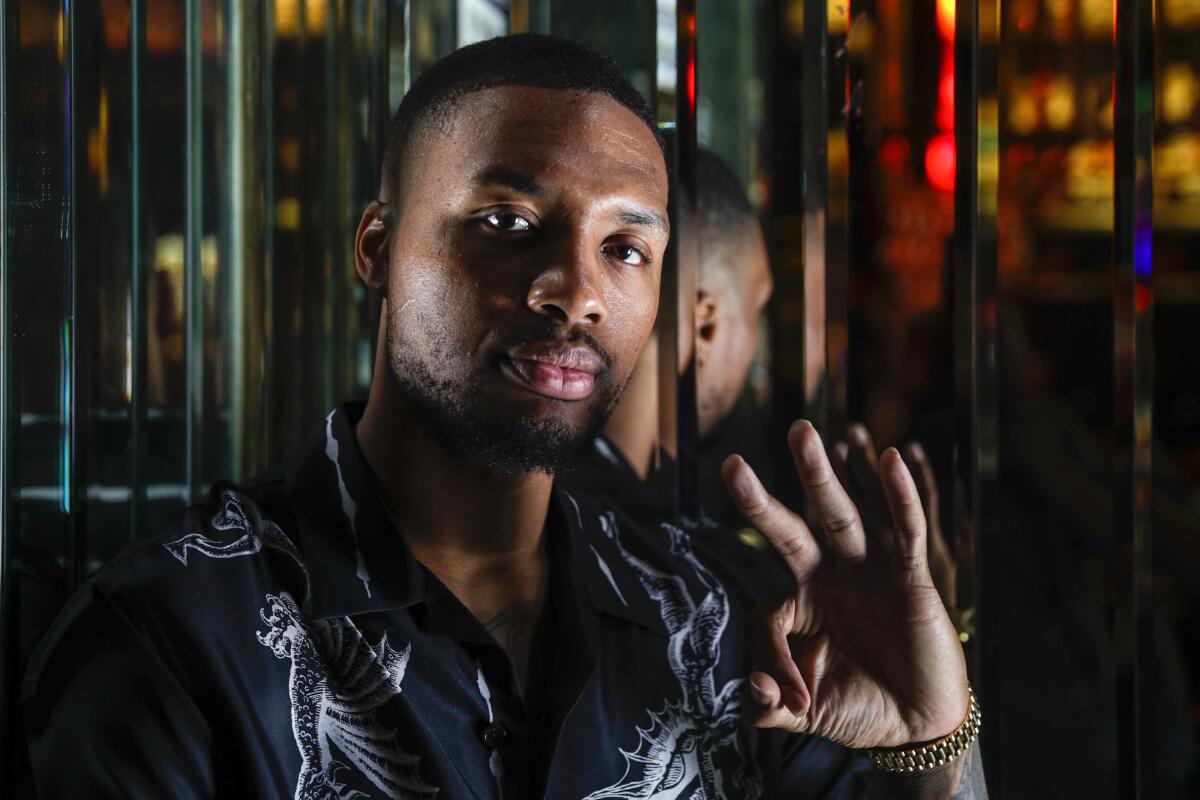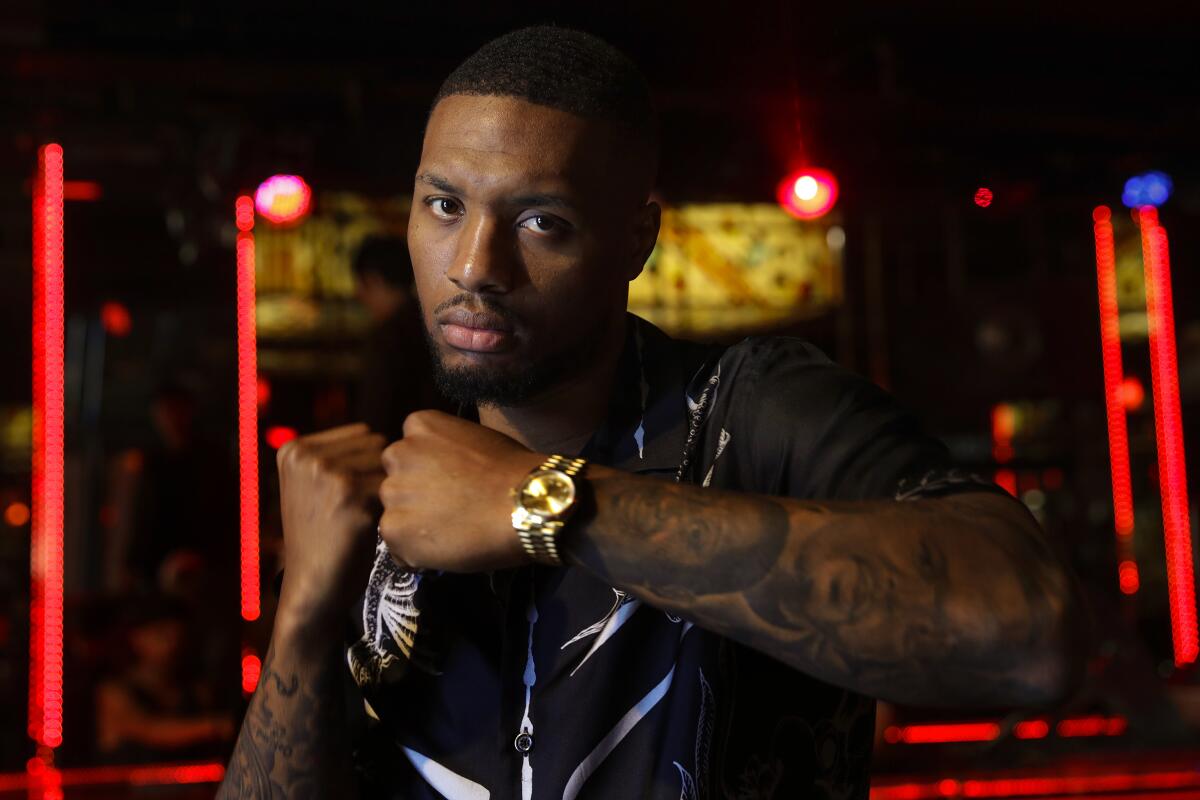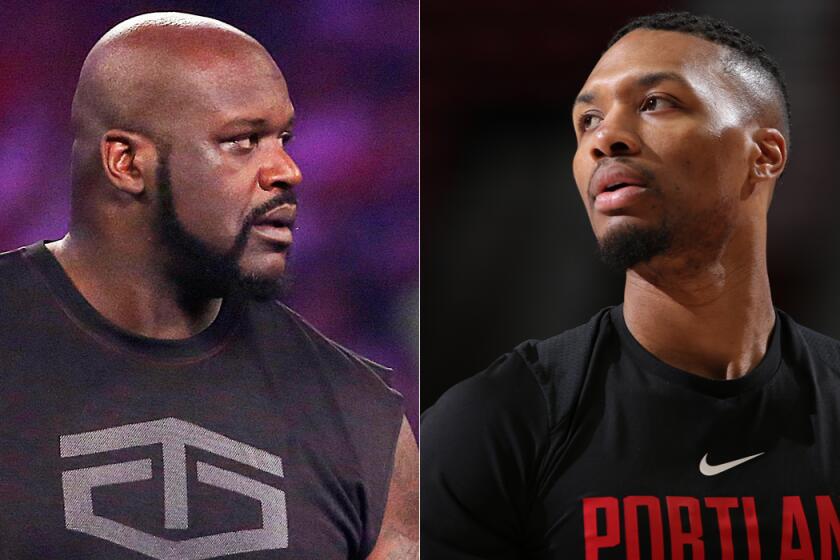Damian Lillard, a.k.a. Dame D.O.L.L.A., tries to beat the rap against athlete rappers

As NBA training camp started last week, one inescapable headline was … wait, a rap battle?
Yes, Shaquille O’Neal and Damian Lillard were going at it one on one.
After publicly questioning Shaq’s rap credibility, the Portland Trail Blazers’ All-Star guard unleashed not one, but two diss tracks targeting the NBA legend. And in this game, Lillard might have the advantage in the court of public opinion.
The idea of athletes becoming rappers is nothing new — O’Neal was one of the first and most commercially successful more than 20 years ago, selling over a million albums — but Lillard’s commitment to the craft has set him apart. He performs as Dame D.O.L.L.A., has his own label, Front Page Music, and in August released his third commercial album, “Big D.O.L.L.A.,” which features popular artists Lil Wayne, Jeremih and Mozzy.
These major co-signs give Lillard credibility in the eyes of music enthusiasts. Add the beef with Shaq, a tiff with fellow baller/rapper Marvin Bagley III of the Sacramento Kings and an impressive freestyle on the “Sway in the Morning” show, and Dame D.O.L.L.A. is a certified M.C.
The acronym Lilliard uses stands for Different on Levels the Lord Allows, which he says reflects the nature of his success on and off the court. A four-time All-Star with six playoff appearances, he has a contract worth $196 million over the next four years. The financial gains aren’t entirely sunk into sports cars, mansions and vacations in St. Tropez; they’re also funding his dream of a rap career.
(Warning: The following video contains explicit language.)

Soon, he’ll release a second music video, for the single “Money Ball.” In the visual, which was recently shot in Los Angeles, Lillard dons a silk shirt as he casually throws cash onto the stage at an empty strip club to match the braggadocious radio-friendly song about making money and living the good life. It answers the questions many people have when hearing that the 29-year-old Oakland native is equally passionate about music and ball.
“The whole idea behind [the video] is just to paint that picture of dedication and how focused I am to my number one job, which is basketball,” Lillard said as he lounged in a green room on set of the shoot on a sunny Friday afternoon. He had changed into an Adidas shirt and shorts and was scrolling through his phone while the next scene was being set up. “Everything else is just not a distraction. That’s the whole point we making. That’s why we in the strip club, but it’s empty. … It’s basically tipping the game of basketball.”

Lillard, who got into rap at a young age, is constantly trying to elevate his craft. He primarily records in the offseason, but is always taking notes and seeking to stay inspired creatively. After three albums, including 2016’s “The Letter O” and 2017’s “Confirmed,” a natural next step was to create music videos.
The first one was for “Big D.O.L.L.A.” cut “Dre Grant,” a tribute to Lillard’s roots in Brookfield Village, a neighborhood in Oakland. The song’s namesake is the uncle of Oscar Grant, a 22-year-old black man who was shot and killed by police early New Year’s Day in 2009 and was the subject of the critically acclaimed movie “Fruitvale Station” starring Michael B. Jordan.
The video features Dre Grant and several Brookfield residents as a celebration of the neighborhood. The song doesn’t mention Grant by name, but the bouncy production is reflective of the spirit of the town that he embodies.
“There’s a dance called the Brookfield, it’s the neighborhood dance, and he just do the dance better than everybody else,” Lillard explained. “The song is the perfect song to do the dance to, so that’s why we named it ‘Dre Grant.’”
(Warning: The following video contains explicit language.)

Brookfield Duece, who appears on the song and co-directed the video, is Lillard’s cousin. The family grew up together in a competitive environment, which went beyond sports. Duece said any one of the cousins could have “made it out” of the neighborhood known to be plagued with poverty and violence, but Lillard’s “will to get there was stronger than everyone else’s. He wanted it more than everyone else, which is why he’s there.”
Duece explained why the “Dre Grant” video, which shows neighborhood kids playing basketball, dancing at the gas station and riding the BART train, was so empowering for the community. He used the metaphor of a genie trapped in a lamp or a jack-in-the-box being stuck to describe the hopelessness that can be felt in Brookfield. Lillard’s persona as a basketball player, musician and local celebrity, Duece said, shows the residents, “the genie is so much bigger than the lamp that was holding him in.”
“That’s what ‘Dre Grant’ is doing for the community of Brookfield,” Duece said. “The kids that are growing up and watching that video and saying, ‘I’m bigger than this neighborhood, I’m bigger than this city, I’m bigger than the stereotypes that they give us as black kids in America or black kids in Oakland.’”
Shaquille O’Neal has found himself a new rival in Portland Trail Blazers star Damian Lillard, and the conflict is not being played out on the court, but over music.
Lillard is doing more for the community than putting local kids in a rap video. Supporting upcoming artists is a large reason he is using his platform to create music. Besides the big-name features on “Big D.O.L.L.A.,” Lillard shines light on others by including upcoming artists like Brookfield Duece and Danny from Sobrante, who are both signed to his Front Page Music.
“Some people go they whole life without ever getting an opportunity or ever getting that light shined on ‘em to where the right person listens or the right person sees you or the right fan base comes across that one person and they just blow up,” Lillard said. “But a lot of people never get that opportunity. [Basketball] makes it easier for me because I don’t have a reason to hate on nobody or not give somebody every opportunity, because [rap‘s] not my number one profession in the first place, so I try to use it for that even more. If I can tag people in, then that’s what I’m gonna do.”
::
The cultures of hip-hop and basketball have run parallel for decades, even before hip-hop pioneer Kurtis Blow’s 1984 anthem “Basketball.” O’Neal went platinum with his “Shaq Diesel” album in 1994 and his “Shaq Fu: Da Return” is certified gold. Kobe Bryant briefly had a record deal, as did Hall of Famer Allen Iverson, who was known as a solid lyricist but never released an album because of tensions with the NBA over explicit content.
More recent players to dabble in rap include Iman Shumpert, who has made waves with multiple mixtapes, Lonzo Ball, who has released a few songs, and even LeBron James and Kevin Durant, who recorded a song together years ago.
The emergence of social media may have allowed Lillard to prosper more than his predecessors. One of the steps he used to lay the foundation for his career was an Instagram series, “#4BarFriday,” in which Lillard posted clips of his rapping and held competitions for others to show off their skills.
“#4BarFriday” is how Aaron Williams first heard Lillard. As Hip-Hop Editor for the pop culture magazine Uproxx, he took note of the player’s talents and has been impressed by his growth and commitment to the craft. Williams cites the support from respected figures in hip-hop as evidence that Dame D.O.L.L.A. is the real deal.

“[#4BarFriday] was the first indication that he took rap seriously and had the chops and drive to be a really good rapper,” Williams explained. “The fact that luminaries such as Lil Wayne and Talib Kweli have given him their co-signs — Wayne by appearing on [all] of Dame’s albums, Kweli by shouting him out during an episode of his ‘People’s Party’ podcast presented by Uproxx — just proves that he deserves not just attention and accolades, but also the respect afforded to the top-tier rappers in the game today.”
Lillard doesn’t necessarily think social media is what separates him from the others. He believes being a student of the culture and honoring the process of what it takes to develop as an artist is creating his success off the court. Before releasing an album, he took the momentum from “#4BarFriday,” released free music on SoundCloud, performed shows and continued building his platform.
“I did the whole process like any other artist did while having my basketball career,” he said. “So I think with a lot of athletes, sometimes it’s just like they jump in as ‘I’m so and so, listen to my music,’ instead of like taking the time to build they career up as an artist. And that way everybody else will respect it because you did it how everybody else would have to do it.”
Building respect comes easy for Lillard, who travels with his childhood friends. His authenticity was evident on the “Money Ball” set as he joked with his crew between takes. He reminisced with friend Drake Green about a time he was angry when a kid on the school bus stepped on his shoes. The room erupted in laughter. Green played high school basketball with Lillard and contributed a guest verse on Lillard’s first album.
“I’m not part of his creative team, but I mean that’s family to me,” Green said. “Anything he wants, I’m just here to support.”
Mooyagi has known Lillard since elementary school and is in charge of Lillard’s graphic design and creative direction. He designed several of Lillard’s Adidas products and also the album cover art for “Big D.O.L.L.A.” Having worked with Lillard on both his sports ventures and music endeavors, Mooyagi has a unique insight into Lillard’s journey.
“It’s cool to see him evolve as a person and an artist and really start to exhaust all his creativity and the different outlets that he feels comfortable dabbling in,” he said. “‘Cause I feel like a lot of times, people will confine themselves and their creativity to one thing, but he’s using his platform to touch a lot of different avenues, and I feel like people don’t really take advantage of things like that.”
The “Big D.O.L.L.A.” cover art that Mooyagi and Lillard created features Lillard sitting on a bronze Bentley truck while his year-old son, Damian Jr., sits in a matching kids car. The image is formatted like a Polaroid photo, complete with the album title designed to look like it was written with a marker.
Even though Lillard is thankful for the boost basketball has provided him and the opportunity to rap about the money he’s made, he wants his legacy as a father, friend and native of Brookfield to be something permanent.
And in the short term? Seems that he’d really like it if Shaq left the rapping to him.
As Lillard declares on his second diss track “I Rest My Case”: “You’re not a rapper, you comedy, commentary and actor/ Feed him with a slingshot, you better call the pastor/David and Goliath, your stature’s a non-factor.”
More to Read
Go beyond the scoreboard
Get the latest on L.A.'s teams in the daily Sports Report newsletter.
You may occasionally receive promotional content from the Los Angeles Times.












